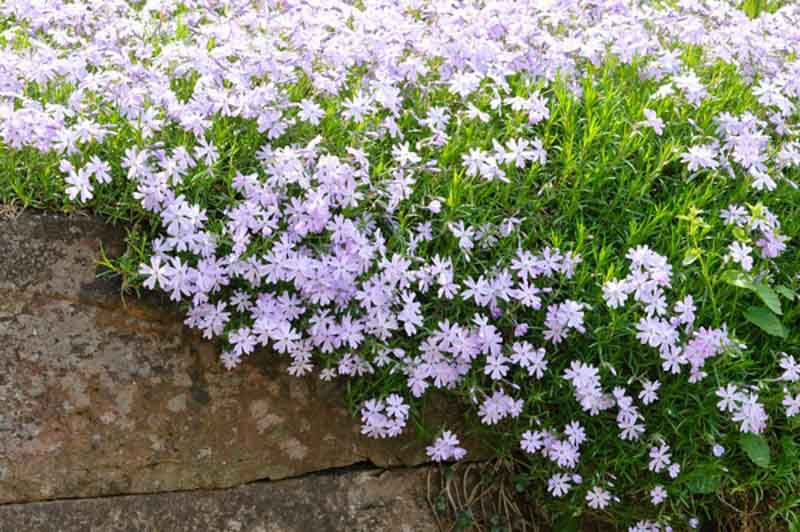Phlox Emerald Cushion Blue is a lovely evergreen perennial in the phlox family that forms a low, mat-like mound of foliage topped with abundant lavender-blue flowers in spring and summer. This compact plant has received the Royal Horticultural Society’s Award of Garden Merit for its outstanding ornamental qualities. With its carpeting habit, long bloom time, and easy care nature, Phlox Emerald Cushion Blue makes an excellent addition to rock gardens, edging, containers, and more.
Overview of Phlox Emerald Cushion Blue
Phlox Emerald Cushion Blue, also referred to as moss phlox Emerald Cushion Blue, is a low-growing perennial that typically reaches 4-8 inches tall with a spread of 12-18 inches wide. It exhibits a spreading, mat-forming habit and remains evergreen throughout the year. The small needle-like leaves are bright green in color.
From late spring to early summer, abundant lavender-blue flowers appear on short stems rising just above the foliage. The five-petaled, salver-shaped blooms measure about 0.5 inches across. Deadheading spent flowers encourages additional blooming into the summer. Overall, Phlox Emerald Cushion Blue displays a lush carpet of foliage blanketed with color for weeks.
Growing Conditions for Phlox Emerald Cushion Blue
This compact phlox thrives in full sun and well-drained soil. It tolerates partial shade, especially in hot climates, but flowers most profusely with maximum sunlight. Average to dry moisture levels are preferred. Avoid soggy soils, which can lead to rot.
Phlox Emerald Cushion Blue is quite drought tolerant and adaptable to a range of soil types including sandy loamy chalky, and clay soils as long as drainage is good. It grows well in neutral to slightly alkaline pH levels. Established plantings have good resistance to drought and heat. Hardiness zones are 4-8.
Use organic mulch around plants to conserve moisture and insulate roots. Take care not to bury foliage under mulch. Good air circulation is important to prevent mildew on phlox. Avoid overcrowding plants when planting.
How to Use Phlox Emerald Cushion Blue in Gardens
The compact, spreading form of Phlox Emerald Cushion Blue makes it a great option for the front of borders and pathway edging. It also shines in rock gardens, alpine gardens, and mixed containers. Try combining it with other low-growing alpines like sedums, alyssum, thyme, veronica, and creeping junipers.
Mass several plants together for a dense mat of foliage and flowers. Works nicely cascading over walls or planters. Also effective spilling over edges of raised beds and retaining walls. Compliments larger perennials, ornamental grasses shrubs and small trees. Attracts butterflies! Deer resistant.
Caring for Phlox Emerald Cushion Blue
Phlox Emerald Cushion Blue requires minimal care once established. It may take 2-3 years to reach maturity as the root system develops. Avoid disturbing the shallow roots once planted.
Pruning is not necessary, but clipping back spent flower stems by 1/3 after blooming neatens up plants. Annual shearing to shape and remove dead growth can be done in early spring if needed. Remove any damaged foliage as required to keep plants looking their best.
Water occasionally during drought to prevent severe wilting. Good drainage is key to prevent rot – don’t overwater! Fertilize lightly in early spring with a slow-release or balanced organic fertilizer if plants need a nutrient boost. Division of overcrowded plants can be done every 2-4 years in early spring.
Why Grow Phlox Emerald Cushion Blue?
What makes this compact phlox a must-have for the garden? Here are some of the best reasons to grow Phlox Emerald Cushion Blue:
- Long bloom time from late spring through summer.
- Vivid violet-blue flower color.
- Evergreen foliage remains attractive year-round.
- Spreads to form a dense, weed-suppressing carpet.
- Tolerates heat, drought, and poorer soils.
- Works great as a groundcover or edging plant.
- Low maintenance, no deadheading required.
- Attracts pollinators, resistant to deer/rabbits.
- RHS Award of Garden Merit winner.
- Lovely in containers, rock gardens, borders, and more!
With its superb flowering, evergreen carpet of foliage, adaptability, and easy care, it’s easy to see why Phlox Emerald Cushion Blue is an outstanding compact perennial. No garden should be without this RHS favorite!
Emerald Cushion Blue MSRP:
- Suitable for planting in sunny and partially shaded locations
- Spring flowering time
- Green foliage colour
- Mixed flowering Colour
Availability to buy and flowering time
| J | F | M | A | M | J | J | A | S | O | N | D |
|---|
Emerald Cushion is a moss phlox that will create a beautiful carpet of colour during spring. This perennial will grow a mound of shiny, evergreen leaves that will be covered in pretty lavender-blue flowers from April to May. Emerald Cushion is a great plant for rock gardens and ground cover because it keeps weeds down and can spread up to 50 cm while only growing 10-15 cm tall. 7cm pot plants supplied.
| Mature Height | 15 cm |
|---|---|
| Mature Spread | 50 cm |
| Plant Spacing | 20 cm |
| Soil Type | Fertile, free-draining soil |
|---|
Phlox Collection – Alpines & Small Plants – 2022 Introductions
FAQ
How do you care for emerald blue creeping phlox?
Is Emerald Blue phlox Evergreen?
Does phlox ground cover like sun or shade?
Does phlox stay green all summer?
- The Ultimate Guide to Growing Strawberries in Raised Beds - August 8, 2025
- No-Dig Garden Beds: The Easiest Way to Grow a Beautiful Garden - August 6, 2025
- How to Protect and Preserve Wood for Raised Garden Beds - August 6, 2025

